(MENAFN- Asia Times) At the end of a dry season that saw a sharp escalation in Myanmar's civil war, one incident more than any other will remain seared in collective memory: the slaughter of some 170 civilians, many children among them, in a precision airstrike on a village in northwestern Sagaing Region.
The April 11 atrocity at Pazigyi village where locals had gathered to celebrate the opening of an administrative office run by the opposition National Unity Government (NUG) underscored, like nothing else before it, the unblinking ruthlessness of a military regime now irrevocably committed to a campaign of strategic terror against its own people.
The bloodiest single incident in the war to date also served horrifically to illustrate the spearhead role of the Myanmar Air Force (MAF) in efforts by the military's State Administration Council (SAC) to bludgeon the population into submission.
Over the dry season months, MAF jets and helicopter gunships ratcheted up the tempo of daily strikes which in addition to supporting the regime's embattled ground troops also deliberately targeted villages, clinics, churches and even camps where hundreds of thousands of internally displaced people (IDPs) have sought precarious refuge.
But for all the publicity and outrage they have drawn, the SAC's Russian-built Yak-130 jets and Mi-35 gunships were not in fact the most important killers shaping the course of the conflict in recent months. That lethal accolade should rather go to the humble assault rifles and grenade launchers now turbocharging resistance across the flatlands of central Myanmar.
Small arms power Over the past five months of this year's dry season, an accelerating proliferation of automatic rifles and other small arms seldom seen in 2021 and 2022 has wrought a striking if virtually unreported transformation of the war.
Likely to gather further momentum during the impending rainy season and beyond, the new firepower and the impact on the trajectory of ground combat it is driving have long-term strategic implications far more consequential than murder of non-combatants from the air.
At the most visible level reflected in almost every image emerging from Myanmar's warzones, the small-arms turn-around has seen tens of thousands of automatic rifles moving into the hands of Peoples Defense Force (PDF) fighters not only in border zones controlled by ethnic resistance organizations but also across the majority Bamar regions of Sagaing, Magwe and Bago in the center of the country.
Distribution has clearly been uneven and inadequate but as occasional interdictions publicized by the regime have made clear, consignments of hundreds of weapons at a time have been moving into the national heartland.
Their effect on fighters armed in the first two years of resistance with single-shot hunting rifles or homemade guns has been telling both psychologically and tactically, shaping loose bands into increasingly organized and often uniformed military units and allowing for longer, harder-hitting engagements.
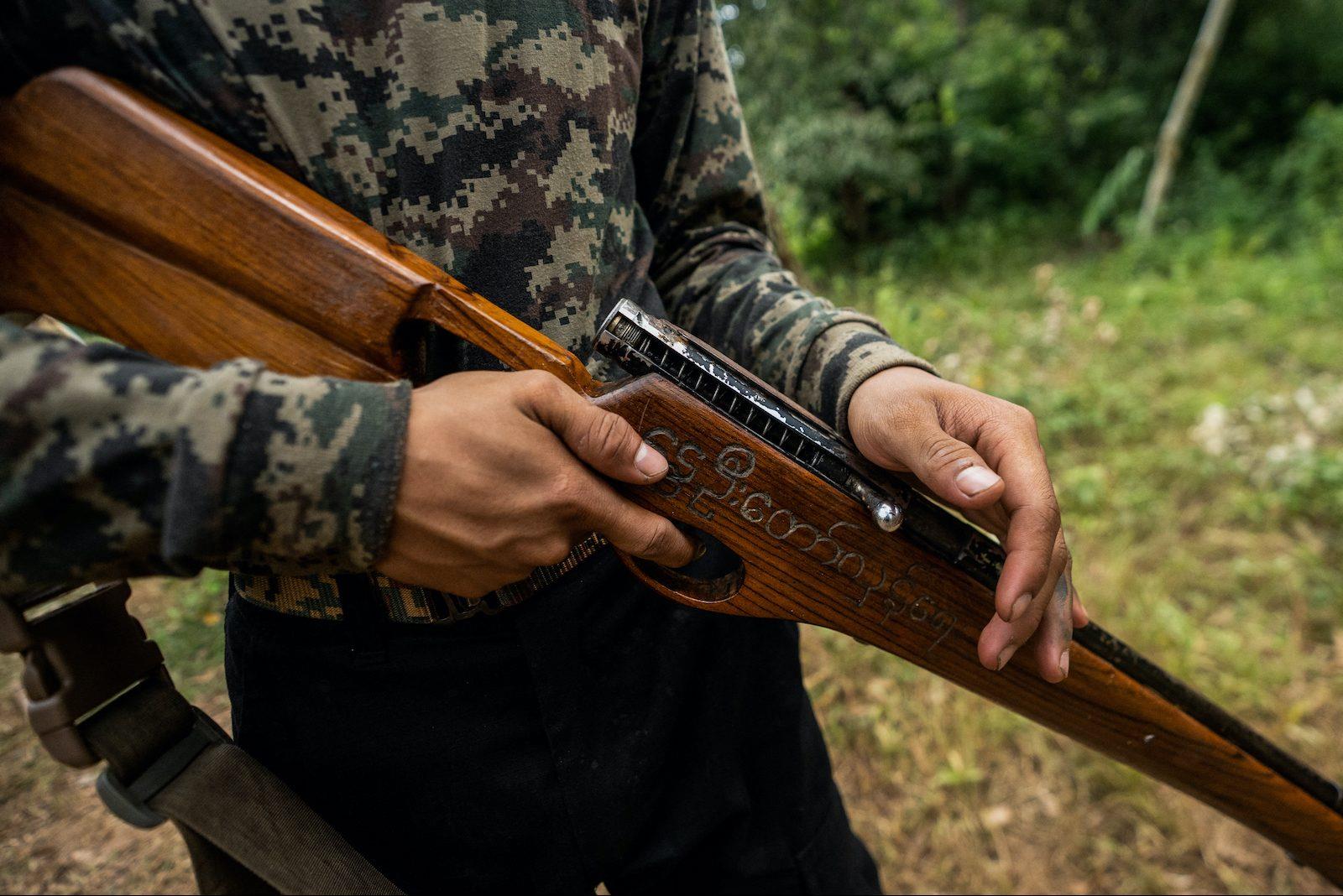
A member of the Karenni People's Defense Force holds a homemade gun adorned with the words 'Spring Revolution' in Burmese script as he takes part in training at a camp near Demoso in Kayah state on July 7, 2021. Photo: AFP
Most of these weapons have been Type-56 assault rifles – the Chinese copy of the venerable Soviet AK-47 – and knockoffs of the Chinese Type-81 that replaced it, both 7.62mm caliber weapons long since phased out of service in China.
But a wide range of more modern, smaller caliber 5.56mm guns is now also in resistance hands including US-manufactured M-4 carbines and M-16s, some apparently new, and German-designed HK-33 rifles once produced under license in Thailand.
Crucially, however, automatic rifles which began to proliferate significantly in the second half of 2022 are now being supplemented by growing quantities of other small arms with the capacity to turn hit-and-run skirmishes into sustained attacks inflicting mounting casualties on junta forces.
These infantry support weapons include light machine guns, hand-held 40mm grenade launchers and, not least, Type-69 rocket-propelled grenades (RPGs), Chinese copies of the Soviet RPG-7.
Responsible for the destruction of thousands of armored vehicles over a ten-year war in the 1980s, it was the RPG-7 more than any other weapon – including the vaunted US-manufactured Stinger surface-to-air missile – that drove exhausted Soviet forces out of Afghanistan.
Rising resistance The proliferation of small arms and light weapons now reshaping the war has drawn on three main sources. Sympathetic ethnic forces ranged against the Myanmar military for decades have been an early and ongoing benefactor for popular resistance forces.
The Karen National Liberation Army (KNLA) on the eastern border with Thailand, the Karenni Army (KA) in Kayah state to the north, and the Chin National Army (CNA) on the border with India have all played crucial roles in sheltering, training and mentoring emerging PDF groups.
But two factions with their own capacity for small arms production have been far more important as armorers of revolt. The Kachin Independence Army (KIA) in the far north and the United Wa State Army (UWSA) in the northeast both produce knockoffs of the Type-81, which more than any other rifle has come to supply new PDF units.
While the KIA is allied to the NUG and firmly committed to toppling the SAC regime, the powerful China-backed UWSA has remained on the fence behind a 34-year-old cease-fire with the military.
Neutrality, however, has failed to dampen Wa commercial instincts: the sale of large quantities of Wa- and Chinese-manufactured weapons to allied ethnic factions, which in turn are arming PDFs, is fundamentally reshaping the contours of the conflict.
In central Myanmar, backing for PDF-Mandalay extended by the ethnic Palaung Ta'ang National Liberation Army (TNLA), a close Wa ally, has emerged as one example among others.
Thanks to TNLA sanctuary and support, a patchwork of would-be urban guerrilla cells hunted down and driven out of Mandalay city by the military in late 2021 and early 2022 has since regrouped as an organized force of possibly up to 1,000 troops based in the hills of Nawnghkio township in Shan state.
Those wooded hills represent strategic high ground overlooking both the city and the Ayeyarwaddy (Irrawaddy) river to the west while sitting astride the main highway extending from Mandalay northeast to Lashio and the Chinese border.
A second major source of arms has involved cross-border trafficking from Thailand. Oiled by systemic corruption, military-grade weapons have undoubtedly leaked from Thai security force armories while a thriving trade in legally imported and purchased guns later sold onto the black market has provided a range of other firearms.
Imagery on social media platforms used by PDF groups indicates a strikingly diverse array of small arms smuggled from Thailand including US-produced AR-15 semi-automatics, Belgian FN-FAL automatics, Singaporean Ultimax light machine guns, brand new Turkish Derya semi-automatic shotguns and an assortment of obsolete firearms dating from the Indo-China wars of the 1970s and 1980s.
Repeated sweeps by Thai provincial and Bangkok metropolitan police during 2022 that seized thousands of illegal firearms, mostly traded online, provided some indication of the scale of the small-arms black market in the kingdom.
It remains unclear whether the regularity of those hauls and the media publicity surrounding them served to mollify repeatedly voiced SAC concerns that Bangkok has not done enough to stem cross-border arms trafficking to resistance forces.
At least through the first half of 2022, the third-most important source of firearms reaching the resistance undoubtedly consisted of weapons manufactured by PDF groups themselves. In addition to channeling millions of dollars into black market purchases from foreign sources, the NUG's Ministry of Defense (MoD) has also organized and equipped production facilities reportedly run by defectors from the military.
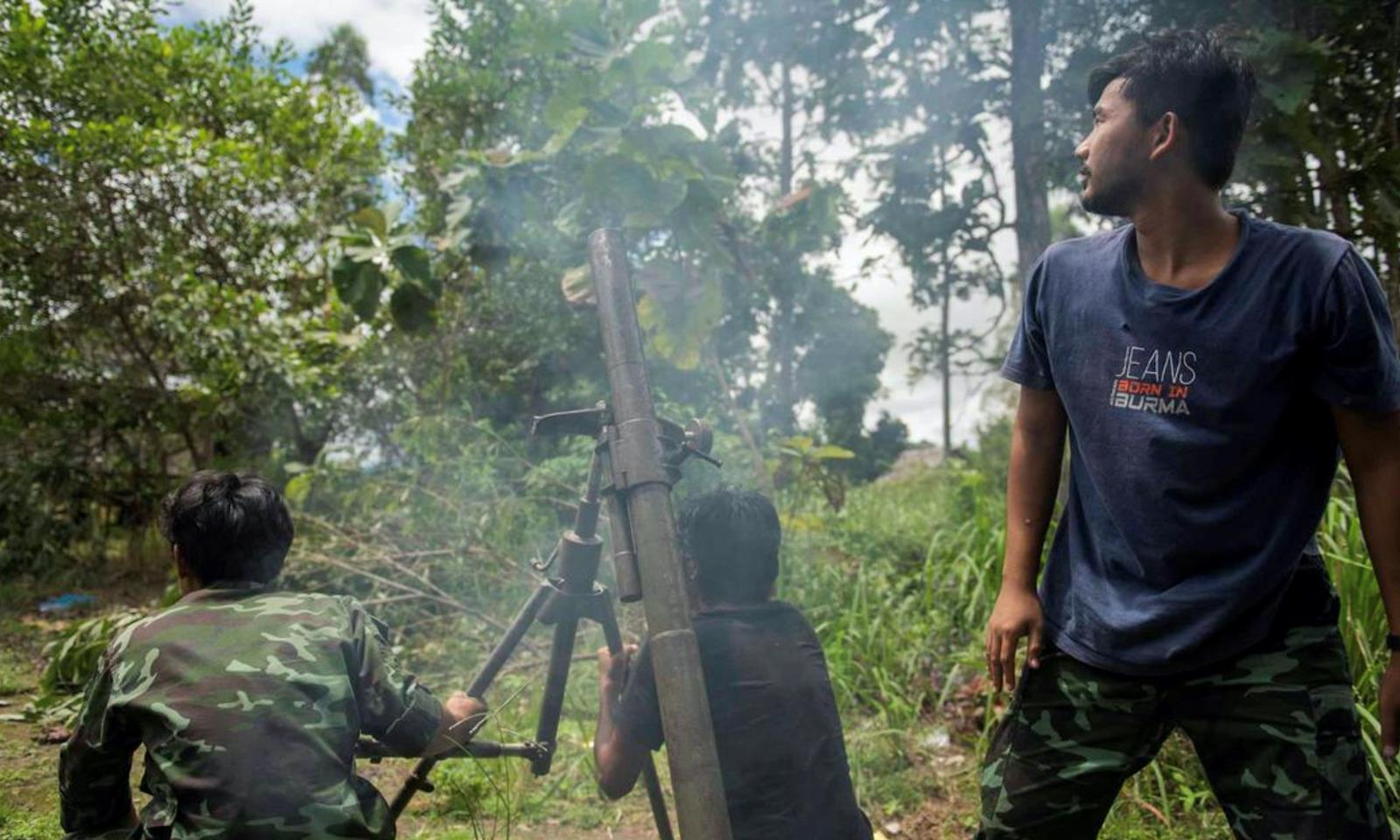
A Myanmar PDF launches an assault. Image: Facebook
From early beginnings in late 2021, the countrywide development of drone warfare by PDFs has been a remarkably innovative element of a process which has also produced jerry-rigged mortars and rockets.
But by late 2022 and accelerating into this year, the importance of local production in arming PDFs has almost certainly been challenged and perhaps eclipsed by a more reliable source: the enemy. Weapons captured from the Myanmar Army and police typically consist of standard 5.56 mm MA-1 and MA-3 domestically-produced assault rifles, supplemented by obsolescent MA-11 rifles used by the police.
During the first two years of the war, seizures of heavier weaponry such as mortars, machine guns and RPGs were largely limited to border areas where well-organized ethnic insurgent forces, most notably the KNLA and allied PDFs, succeeded in overrunning army outposts and police stations. But as PDFs bring greater firepower to bear, that dynamic is now slowly shifting to targets in the Bamar heartlands.
Tactical advances The spreading access to small arms is still patently insufficient to enable resistance forces to overrun military bases, let alone urban areas. Army strongpoints are typically protected by rings of anti-personnel mines and defended by units of at least 70-150 troops equipped with mortars and usually able to call in rapid air and artillery support.
What current trends are permitting, however, are two other types of offensive operations better suited to a phase of the war which for at least this year and probably through 2024 will likely remain in a period of strategic equilibrium.
Evolving from the period in 2021 when newly formed PDFs were on the defensive, the current phase implies a dynamic balance between a militarily over-extended regime secure only in major urban areas and expanding insurgent forces dominating – and increasingly seeking to administer – wide swathes of the countryside.
The sharp escalation of attacks by better-armed resistance forces during the dry season just ended arguably tilted that balance incrementally in favor of the opposition, a trend that SAC airpower may have slowed but has been unable to halt.
Gathering momentum through the dry season, the first type of operation has involved attacks on small police stations and outlying posts serving to tighten the noose around larger bases and seeing more weaponry falling into resistance hands. Hit-and-run raids on strongholds inside urban areas also spiked notably in recent months, most strikingly in Monywa city, the Sagaing headquarters of the army's Northwestern Regional Command.
As importantly, the proliferation of automatic weapons and other small arms is enabling more effective road ambushes and interdiction of supply convoys. Since mid-late 2021, ambushes using widely produced improvised explosive devices (IEDs) have been a staple resistance tactic.
But while mauling military movements and imposing an undoubted psychological cost, IEDs alone have never proved capable of destroying entire convoys or interdicting major highways.
In recent months, however, that situation began to change. Emblematic of the shift was the widely reported destruction in April of a convoy moving from an army operations base in the Sagaing town of Kalay up into the hills of Chin state to resupply units in the state capital, Hakka.
Reported to number some 30 requisitioned trucks escorted by two Brazilian-manufactured Cascavel armored cars, the convoy was wiped out over a period of days by attacks mounted by the Chin resistance involving IEDs, small arms and ordnance dropped from drones.
In early May, another convoy manned by troops of the crack 77th Light Infantry Division (LID) attempting to reach Hakka from Gangaw in Magwe Region, 85 kilometers to the south, was decimated with a slew of weapons including a mortar and a RPG reportedly falling into resistance hands. Regime garrisons across Chin state now rely almost entirely on resupply by helicopter, a situation largely mirrored on the other side of the country in Kayah state.
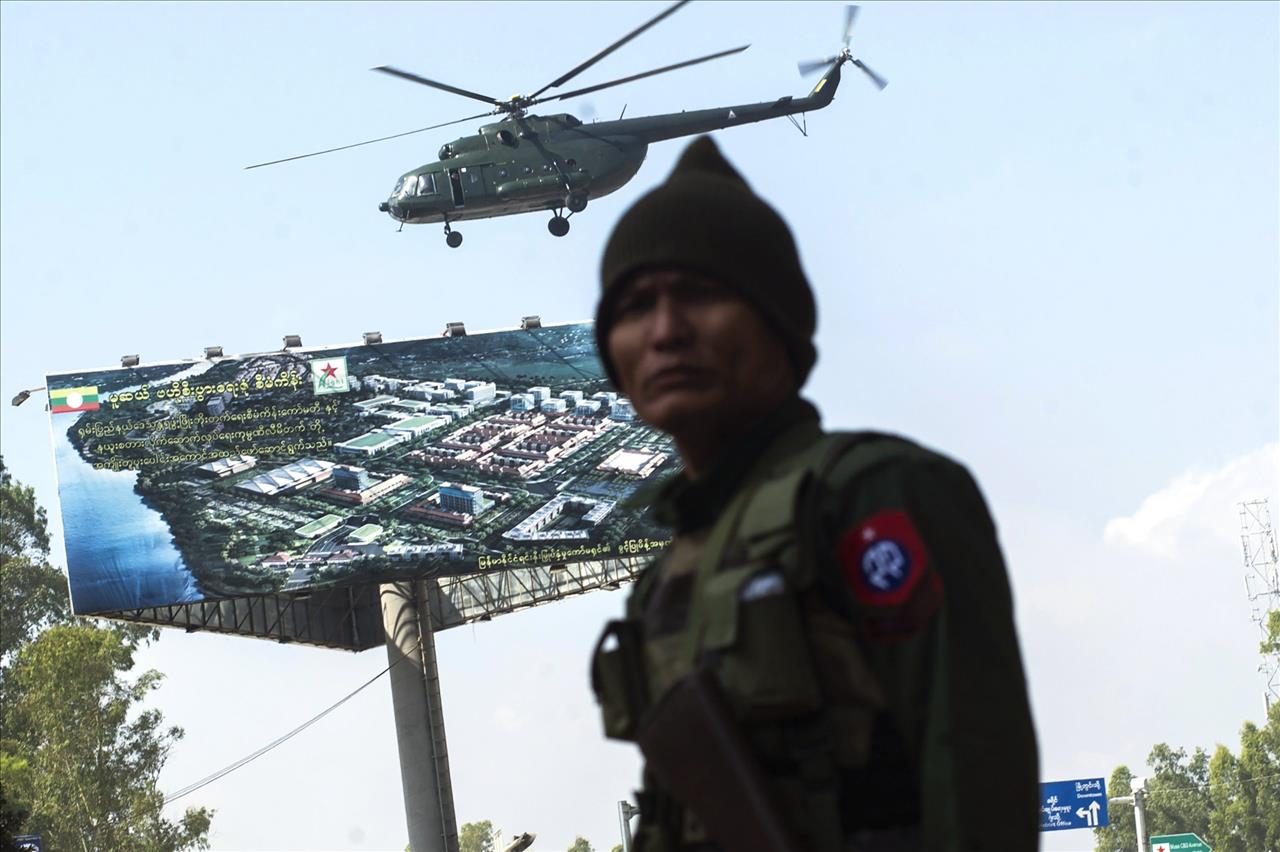
A Myanmar government soldier secures the ground while military helicopter carrying troops takes off from Muse located in Shan state of Myanmar near China's border in a file photo. Image: AFP / Ko Sai
Ambushes are undoubtedly more easily conducted on the winding mountain roads of Chin and Kayah state where vehicles move slowly, and the resistance dominates high ground. But significantly they are now migrating onto the flat lands of Myanmar's bitterly contested dry zone.
In mid-May, a video posted by a group of PDFs of an ambush of a supply convoy on the main highway across Myaung township on the southern edge of Sagaing graphically illustrated the shifting battlefield.
The tactics of a clearly untrained team of 15 to 20 youths were poor but the weaponry they brought to the fight marked a quantum leap from what PDFs in that region might have fielded last year: in addition to Type-56 assault rifles, the attackers were armed with two Vietnam War-era Chinese RPD light machine guns (likely UWSA cast-offs) and three RPGs, any one of which fired from closer range by trained fighters could have destroyed a truck and opened up those halted behind it to concentrated small arms fire.
National arteries under threat Unsurprisingly under these circumstances, the few concerted offensive operations that Naypyidaw's desperately under-manned army was able to mount during the dry season appeared aimed at relieving or preempting resistance pressure on major communication and supply arteries, with the brunt of the fighting focused on northern Kachin state, central Mandalay and Bago regions, and eastern Karen state.
Beginning in late March and lasting into April, almost continuous clashes in the north saw infantry battalions backed by often intense air strikes attempting to clear KIA-supported PDF units from parts of three strategic townships on the Ayeyarwaddy: Shwegu located on the southern border of Kachin state, and neighboring Katha and Tigyang in Sagaing.
With military road movements vulnerable to interdiction by KIA and PDF forces, and railway services between Mandalay and the Kachin state capital of Myitkyina already suspended, the river has become a vital artery for the resupply of army forces in Kachin.
Further south in Mandalay Region, mid-April operations by elements of the army's 88th LID targeted resistance forces in Tagaung and Thabeikkyin, townships on the Ayeyarwaddy and the highway which runs along the river's eastern bank.
Thabeikkyin is potentially threatened by a build-up of PDF forces around the ruby-mining center of Mogok to the east and in the neighboring Shan state township of Nawnghkio.
Where Bago Region meets the Karen hills, hostilities in April centered on Kyaukkyi township overlooking the Sittang River valley and the main north-south highway between Yangon and Naypyidaw.
Further south, meanwhile, fighting flared repeatedly along the Asia Highway, a crucial trade artery linking the Karen state capital of Hpa'an with Myawaddy on the border with Thailand, which has been repeatedly cut by the KNLA's 6th Brigade and allied PDFs.
Mounting resistance pressure threatening Myanmar's major communications and transport arteries made possible by access to small arms and light weapons appears so far to be the result of uncoordinated initiatives undertaken by different fronts of a still fragmented resistance movement.
But as the war develops into 2024 and beyond, there will be a growing requirement for overarching strategic vision, debate, planning and, eventually, coordination.
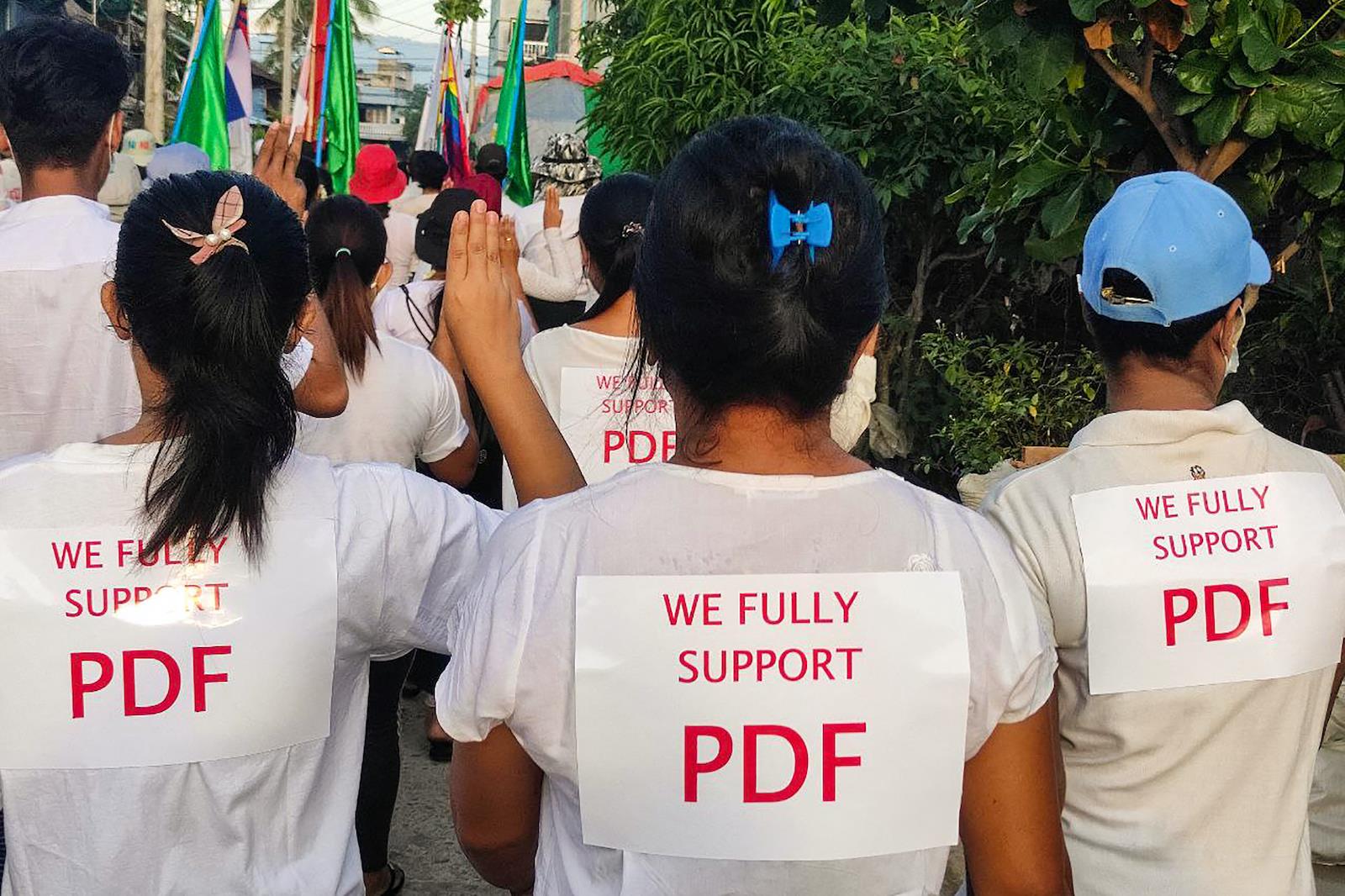
Protesters wearing signs in support of the People's Defence Force (PDF) during a demonstration against the military coup in Dawei. Photo: Handout / Dawei Watch
The task of developing those preconditions for success will necessarily fall to the political and military center of Myanmar's resistance in close liaison with ethnic allies around the nation's peripheries.
As the tide of war shifts slowly against a militarily beleaguered and politically bankrupt regime, the NUG and its MOD still have time to build a framework for strategic cooperation that ethnic forces can accept and support.
But that will require a level of war-time leadership, to date conspicuously lacking, that is seen to move beyond bureaucratic posturing via Zoom meetings and onto the battlefield itself.
Like this:Like Loading...



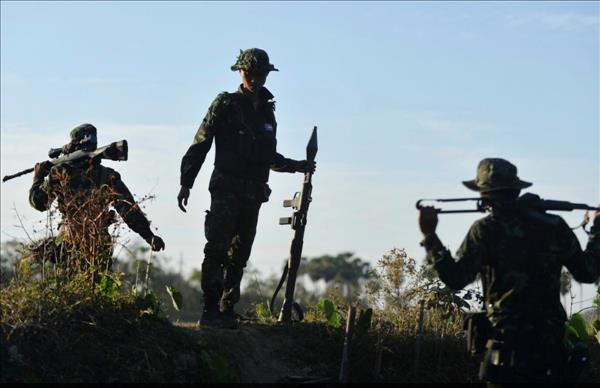



















Comments
No comment